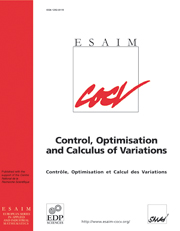Crossref Citations
This article has been cited by the following publications. This list is generated based on data provided by
Crossref.
Dunbar, W.B.
Petit, N.
Rouchon, P.
and
Martin, P.
2003.
Boundary control of a nonlinear Stefan problem.
Vol. 2,
Issue. ,
p.
1309.
Meurer, T.
and
Zeitz, M.
2005.
Feedforward and Feedback Tracking Control of Nonlinear Diffusion−Convection−Reaction Systems Using Summability Methods.
Industrial & Engineering Chemistry Research,
Vol. 44,
Issue. 8,
p.
2532.
Hinze, Michael
and
Ziegenbalg, Stefan
2007.
Optimal control of the free boundary in a two-phase Stefan problem.
Journal of Computational Physics,
Vol. 223,
Issue. 2,
p.
657.
Aubin, Jean-Pierre
Bayen, Alexandre M.
and
Saint-Pierre, Patrick
2008.
Dirichlet Problems for some Hamilton–Jacobi Equations with Inequality Constraints.
SIAM Journal on Control and Optimization,
Vol. 47,
Issue. 5,
p.
2348.
Meurer, T.
and
Zeitz, M.
2008.
Model inversion of boundary controlled parabolic partial differential equations using summability methods.
Mathematical and Computer Modelling of Dynamical Systems,
Vol. 14,
Issue. 3,
p.
213.
Di Meglio, Florent
Rabbani, Tarek
Litrico, Xavier
and
Bayen, Alexandre M.
2008.
Feed-Forward river flow control using differential flatness.
p.
3895.
Aubin, Jean-Pierre
Bayen, Alexandre M.
and
Saint-Pierre, Patrick
2009.
Dirichlet problems for some Hamilton-Jacobi equations with inequality constraints.
p.
1218.
2009.
Flatness-based control of open-channel flow in an irrigation canal using SCADA [Applications of Control].
IEEE Control Systems,
Vol. 29,
Issue. 5,
p.
22.
Meurer, T.
and
Kugi, A.
2009.
Trajectory Planning for Boundary Controlled Parabolic PDEs With Varying Parameters on Higher-Dimensional Spatial Domains.
IEEE Transactions on Automatic Control,
Vol. 54,
Issue. 8,
p.
1854.
Rabbani, Tarek S.
Meglio, Florent Di
Litrico, Xavier
and
Bayen, Alexandre M.
2010.
Feed-Forward Control of Open Channel Flow Using Differential Flatness.
IEEE Transactions on Control Systems Technology,
Vol. 18,
Issue. 1,
p.
213.
Meurer, Thomas
and
Krstic, Miroslav
2010.
Nonlinear PDE–based motion planning for the formation control of mobile agents.
IFAC Proceedings Volumes,
Vol. 43,
Issue. 14,
p.
599.
Utz, T.
Meurer, T.
and
Kugi, A.
2010.
Trajectory planning for quasilinear parabolic distributed parameter systems based on finite-difference semi-discretisations.
International Journal of Control,
Vol. 83,
Issue. 6,
p.
1093.
Knuppel, Torsten
Woittennek, Frank
and
Rudolph, Joachim
2010.
Flatness-based trajectory planning for the shallow water equations.
p.
2960.
Meurer, Thomas
2011.
Flatness-based trajectory planning for diffusion–reaction systems in a parallelepipedon—A spectral approach.
Automatica,
Vol. 47,
Issue. 5,
p.
935.
Schorkhuber, B.
Meurer, T.
and
Jungel, A.
2012.
Flatness-based trajectory planning for semilinear parabolic PDEs.
p.
3538.
Meurer, Thomas
2013.
Control of Higher–Dimensional PDEs.
p.
223.
Meurer, Thomas
2013.
Encyclopedia of Systems and Control.
p.
1.
Schorkhuber, Birgit
Meurer, Thomas
and
Jungel, Ansgar
2013.
Flatness of Semilinear Parabolic PDEs—A Generalized Cauchy–Kowalevski Approach.
IEEE Transactions on Automatic Control,
Vol. 58,
Issue. 9,
p.
2277.
Ng, James
Aksikas, Ilyasse
and
Dubljevic, Stevan
2013.
Control of parabolic PDEs with time-varying spatial domain: Czochralski crystal growth process.
International Journal of Control,
Vol. 86,
Issue. 9,
p.
1467.
Maidi, Ahmed
and
Corriou, Jean-Pierre
2014.
Boundary geometric control of a linear Stefan problem.
Journal of Process Control,
Vol. 24,
Issue. 6,
p.
939.




